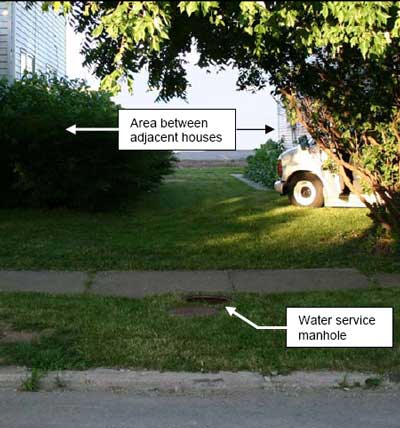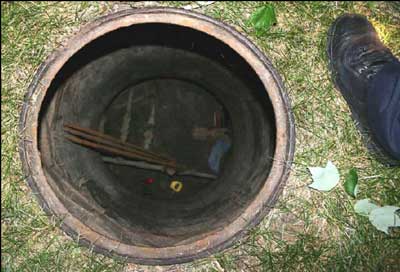Handyman Plumber Asphyxiated in Entry into Water Service Manhole Vault
Iowa Case Report: 05IA042
Report Date: June 19 2007
Summary
Early in the summer of 2005 a 67-year-old, self-employed handyman died upside down, head first in a water service manhole. His shoulders and head pressed against the sand at the bottom of the manhole pit. He had been called to fix a water leak in an adjacent rental house. The on/off valve for the public water supply to this house was in this pit or vault, 1.7 m (5.5 ft) below the manhole cover. Tools to operate the valve were stored reachable from above ground level inside the manhole vault. He worked alone, his death was not witnessed, and his body was not immediately discovered. First responders found no abnormal oxygen levels, combustibles, or toxic air contaminants in the manhole vault at the time of the rescue. The victim was extricated and transported. It was determined that his death resulted from positional asphyxia.
RECOMMENDATIONS:
- Identify property and workplace hazards such as confined spaces.
- Eliminate or reduce confined space hazards and associated risks.
- Develop and implement a comprehensive and effective confined spaces program.
- Establish and enforce a contractor safety program.
Introduction
A 67-year-old, self-employed handyman was called to repair a water leak by a representative of the absentee owners of two adjacent, unoccupied houses for rent. The victim arrived on the job at the beginning of a normal business day. It was evening before he was considered missing and was later found head first in the manhole entry to the vault containing valves that control the water supply to the residences. The incident was not witnessed. The cause of death was determined to be positional asphyxiation because the position in which he was restricted prevented him from breathing adequately.
Iowa FACE investigators became aware of this incident through a newspaper press clipping within five days of its occurrence, performed preliminary investigative work during the fall of 2005, and conducted onsite interviews with representatives of the property owners in February 2006. Additional information and photographs were obtained from the local police and fire
departments as well as medical examiner and autopsy reports. The water service provider and
the professional association for home inspectors were also consulted.
Investigation
It was early summer 2005, a calm, pleasant day in the residential neighborhood of the eastern Iowa city where this incident occurred. A 67-year-old handyman (independent contractor) responded to a call from a member of a group of professional service providers who also owned and managed rental properties. The repairman’s job assignment was to fix a water leak in one of the two unoccupied rental properties adjacent to the business where the members of the property owners’ group worked. The owners’ group had purchased these rental properties earlier in the spring from a coworker, who died shortly before the victim.
Since his retirement, the victim had performed a variety of odd jobs for a local building contractor, this property owners’ group, and others. This job was special because not only did the victim maintain the group’s office and properties, he also occasionally worked for individual members of the group. It was both a business relationship and a friendship which had grown over a decade. The victim was instantly recognized by the staff of the professional services business when he arrived shortly after 8 AM to obtain the keys and go to work at the nearby rental house.
Members of the owners’ group typically stopped and visited with this repairman while he worked as they came and went throughout their business day. This time it was different. The handyman had come, gotten the keys, and gone to work. He parked his service van with its supplies and tools on the lawn. Bushes partially obscured the van in this unusual parking place between the houses, and between the houses and the sidewalk along the street (Photo 1). Usually his service van was in the designated parking area north of the houses, where the business owners also parked their vehicles. They would see his van and find him to talk, but not on this day. It was evening and the victim was late for dinner, again, before his wife grew concerned and requested help to find him. He was discovered upside down in the street-side water service manhole.
 |
|
Photo 1 – Handyman’s van parked on lawn between houses near water service manhole in boulevard along dead end side street.
|
The manhole was located along a portion of a dead end side street, in the grass boulevard between the sidewalk and curb (Photo 1). The victim could not easily be seen where he was found. He was headfirst into the opened manhole with the full length of his body in the cylinder of the vault. The weight of his body forced his head to the side against the sandy bottom. Although a neck injury was initially considered a possibility, the autopsy revealed no such injury. His legs sagged limply against the sidewall of the cylinder with the bottoms of his feet just below the ground-level opening of the manhole.
Access to the manhole required tools to remove the 430 mm (17 in) diameter cast metal disk that sat flush in its metal collar. The zone immediately below this cover was the shape of a pipe or cylinder 0.7 m (27 in) in diameter extending downward 1.5 m (5 ft). The upper 0.6 m (2 ft) of this cylinder was lined with bricks stacked flat without mortar and the lower part was a concrete cylinder with a smooth inside surface. The diameter of the final 350 mm (14 in) from the bottom of this cylinder to the sand floor of the vault flared out to an unmeasured diameter.
Approximately 175 mm (7 in) up from the sand floor, midway up in the flared-out bottom zone, a 25 mm (1 in) diameter water line ran horizontally, a little off of center, across the pit (Photo 2). Connected to this supply line were three water lines, one for each house served on that side of the street. Each water line had an inline shutoff valve. The private company supplying water for the city did not own nor did they lease this service manhole from the property owners. Hand tools (rods with tools attached to their ends) to operate the shutoff valves without entering the manhole were propped within reach against the side of the cylindrical shaft.

|
|
Photo 2 – Shutoff valves at bottom of manhole vault controlled the supply of water to adjacent homes. Tools for operating them lean across the entry way.
|
The water valve to the residence experiencing the water leak had been turned off prior to the repair work. The victim completed the repair work and returned to the manhole, knelt next to its opening, leaned over and down into it blocking ambient light. It appears he was not using the hand tools stored in and propped against the side of the manhole to operate the valves. A flashlight, screwdriver, and the keys to the residences were found on the surface of the sand at the bottom of the pit.
Police and fire rescue personnel responded quickly. They immediately started rescue procedures in conformity with their confined space rescue protocols. The manhole pit was evaluated for non-entry rescue, its internal environment tested for fumes and air quality. No abnormal oxygen levels, combustibles, or toxic air contaminants were found. The victim was extricated through the manhole within 20 minutes and transported to a nearby hospital where he was pronounced dead.
It is not known whether the victim was stretching his reach down toward the water lines to free a stuck valve, retrieve an object, or to perform some other task and then became stuck, unable to maneuver himself up out of the manhole. Nothing was found (such as a string) to indicate he planned to lower items to the floor of the pit or that he was attempting to retrieve such items, if they were dropped, from a position outside the manhole’s entry plane. Neither foul play nor adverse, transitory environmental conditions are suspected. Headfirst, part way into the manhole, the victim lost consciousness and slumped into the position in which he was found.
Cause of Death
The cause of death according to the autopsy was “positional asphyxia”. Positional asphyxia occurs when someone’s position prevents them from breathing adequately. People can die from positional asphyxia by simply getting themselves into a breathing-restricted position from which they cannot move.
Recommendations/Discussion
Recommendation #1 Identify property and workplace hazards such as confined spaces.
Discussion: A hazard has the potential to cause harm. Identification of hazards is therefore fundamentally important so that identified hazards can be eliminated, reduced, or otherwise managed. Hazard identification, assessment, evaluation, and communication should be integral to the acquisition process considerations for commercial real estate transactions. In addition to onsite reviews, information helpful to hazard identification and communication may be contained in real estate transaction disclosure documents.
Many workplaces have spaces that contain exposures to physical hazards, such as moving machinery, flowing materials, or a hazardous atmosphere, or have places which impede the activity of anyone who enters, exits, or works in such confined spaces. The U.S. Department of Labor, Occupational Safety and Health Administration, has defined confined spaces and those spaces for which a permit is required before entry is allowed. Property owners and employers should determine if their premises and workplaces have spaces which would qualify as a permit-required confined space.
Recommendation #2 Eliminate or reduce confined space hazards and associated risks.
Discussion: Following identification of confined spaces, an evaluation should be performed to determine if entry into the identified confined spaces is necessary. Primary consideration should be given to eliminating the confined space or changing the location of the task which is to be performed to outside the confined space. In this case, a water shutoff valve inside the house would not have required the handyman to go near the manhole to perform his repair duties.
Next, when the confined space cannot be eliminated, consideration should be given to enabling completion of the task from outside the confined space. Hand tools were provided to operate the water control valves in this incident without entering the manhole pit. The reason these tools were not used is unknown. Signage informing of the potential hazard, procedures to follow, and location of tools to be used should be considered for posting outside the closed manhole.
Recommendation #3 Develop and implement a comprehensive and effective confined spaces program.
Discussion: OSHA standard 29 CFR 1910.146 contains the requirements for protecting persons from the hazards of entering permit-required confined spaces. If employees or contract workers are not to enter or work in a permit-required confined space, then effective measures must be put in place to prevent entry into such spaces. If workers are allowed or expected to enter permit spaces, a written permit space program must be developed, available, communicated, and effectively implemented.
Recommendation #4 Establish and enforce a contractor safety program.
Discussion: Employees and other workers who are potentially exposed to confined space hazards, or who have responsibilities and duties relating to confined spaces, should be trained to understand the nature of such hazards and the specific confined space entry procedures contained in their employer’s written program. Contractors, especially those hired to enter permit spaces, must be informed of permit spaces, relevant precautions to be followed, permit space entry procedures, identified hazards, experience with the space, and all other pertinent information regarding hazards and operations in permit spaces.
References
- Code of Federal Regulations 29 CFR 1910.146 Permit-required confined spaces. Washington: U.S. Government Printing Office, Office of the Federal Register.
- (US) Department of Labor Occupational Safety and Health Administration. Confined spaces – OSHA standards. Available at www.osha.govexternal icon. Accessed 25 October 2006.
- NIOSH. Worker deaths in confined spaces. DHHS (NIOSH) Publication Number 94-103, December 1994.
- NIOSH. A guide to safety in confined spaces. US Dept. of Health and Human Services (DHHS) National Institute for Occupational Safety and Health (NIOSH) Publication Number 87- 113 PDF Onlypdf icon, December 1987.
- NIOSH. Preventing occupational fatalities in confined spaces. DHHS (NIOSH) Publication Number 86-110, January 1986.
- NIOSH. Safety and health in confined workplaces for the construction industry – a training resource manual. NIOSH Contract Report. NIOSHTIC No. 00148444. (Printed Copy Only)
- NIOSH. Criteria for a recommended standard.working in confined spaces. DHHS (NIOSH) Publication Number 80-106, December 1979.
- St. Olaf College. Confined space entry – policy and procedures manual. Northfield, MN:
Available at http://wp.stolaf.edu/facilities/confined-space-entry/external icon
Accessed 19 June 2007. (Link Updated 4/8/2015)
Iowa FACE Program
FACE is an occupational fatality investigation and surveillance program of the National Institute for Occupational Safety and Health (NIOSH). In the state of Iowa, The University of Iowa, in conjunction with the Iowa Department of Public Health carries out the FACE program. The NIOSH head office in Morgantown, West Virginia, carries out an intramural FACE program and funds state based programs in Alaska, California, Iowa, Kentucky, Massachusetts, Michigan, Minnesota, Nebraska, New Jersey, New York, Oklahoma, Oregon, Washington, West Virginia, and Wisconsin.
The purpose of FACE is to identify all occupational fatalities in the participating states, conduct in depth investigations on specific types of fatalities, and make recommendations regarding prevention. NIOSH collects this information nationally and publishes reports and Alerts, which are disseminated widely to the involved industries. NIOSH FACE publications are available from the CDC-INFO public information center at 1–800–CDC–INFO (1–800–232–4636).
Iowa FACE publishes case reports, one page Warnings, and articles in trade journals. Most of this information is posted on our web site listed below. Copies of the reports and Warnings are available by contacting our offices in Iowa City, IA.
The Iowa FACE team consists of the following from the University of Iowa: Craig Zwerling, MD, PhD, MPH, Principal Investigator; Wayne Johnson, MD, Chief Investigator; John Lundell, MA, Coordinator; Risto Rautiainen, PhD, Co-Investigator, Martin L. Jones, PhD, CIH, CSP, Co-Investigator, and John Kraemer, PA. From the Office of The State Medical Examiner.
To contact Iowa State FACE program personnel regarding State-based FACE reports, please use information listed on the Contact Sheet on the NIOSH FACE web site Please contact In-house FACE program personnel regarding In-house FACE reports and to gain assistance when State-FACE program personnel cannot be reached.

